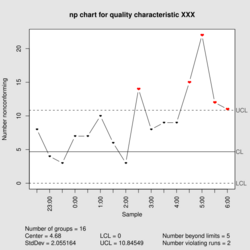np-chart
From HandWiki
| np-chart | |
|---|---|
| Originally proposed by | Walter A. Shewhart |
| Process observations | |
| Rational subgroup size | n > 1 |
| Measurement type | Number nonconforming per unit |
| Quality characteristic type | Attributes data |
| Underlying distribution | Binomial distribution |
| Performance | |
| Size of shift to detect | ≥ 1.5σ |
| Process variation chart | |
| Not applicable | |
| Process mean chart | |
 | |
| Center line | [math]\displaystyle{ n \bar p = \frac {\sum_{i=1}^m \sum_{j=1}^n \begin{cases} 1 & \mbox{if }x_{ij}\mbox{ defective} \\ 0 & \mbox{otherwise} \end{cases}}{m} }[/math] |
| Control limits | [math]\displaystyle{ n \bar p \pm 3\sqrt{n \bar p(1- \bar p)} }[/math] |
| Plotted statistic | [math]\displaystyle{ n \bar p_i = \sum_{j=1}^n \begin{cases} 1 & \mbox{if }x_{ij}\mbox{ defective} \\ 0 & \mbox{otherwise} \end{cases} }[/math] |
In statistical quality control, the np-chart is a type of control chart used to monitor the number of nonconforming units in a sample. It is an adaptation of the p-chart and used in situations where personnel find it easier to interpret process performance in terms of concrete numbers of units rather than the somewhat more abstract proportion.[1]
The np-chart differs from the p-chart in only the three following aspects:
- The control limits are [math]\displaystyle{ n\bar p \pm 3\sqrt{n\bar p(1-\bar p)} }[/math], where n is the sample size and [math]\displaystyle{ \bar p }[/math] is the estimate of the long-term process mean established during control-chart setup.
- The number nonconforming (np), rather than the fraction nonconforming (p), is plotted against the control limits.
- The sample size, [math]\displaystyle{ n }[/math], is constant.
See also
References
- ↑ Montgomery, Douglas (2005). Introduction to Statistical Quality Control. Hoboken, New Jersey: John Wiley & Sons , Inc.. pp. 279. ISBN 978-0-471-65631-9. OCLC 56729567. http://www.eas.asu.edu/~masmlab/montgomery/.
 |

